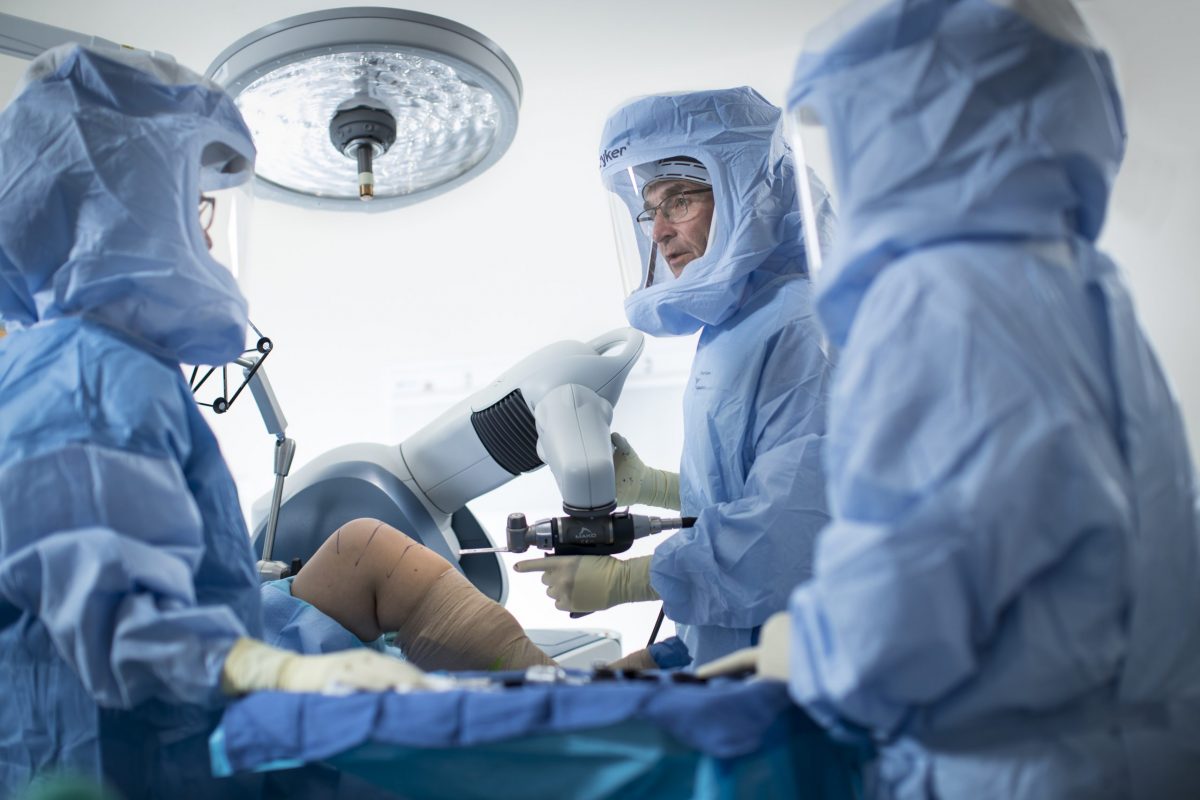Robotic-assisted joint replacement is a super advanced way to fix joints. It uses robots in surgery to make everything very precise and helps people get better faster. This technology means that the new joints fit perfectly, and there are fewer problems after surgery. Patients have smaller cuts, less pain, and don’t need to stay in the hospital for too long. It’s like using cool 3D pictures and real-time info to guide the doctors during the operation. Real patient stories show how great this is, but you need to find doctors who know how to use this technology.
The best part is that it’s getting even better in the future. They’re working on making it even more precise and quicker, and even making special joints just for you.
In a few words, robotic-assisted joint replacement is changing how we fix joints, making them better and giving people a better life.
What is Robotic-Assisted Joint Replacement?
Robotic technology acts as a surgical assistant in joint replacement procedures, ensuring precision and safety for patients.
Here’s how it works:
The surgeon uses a robot with unique arms and tools, like an assistant providing necessary equipment. These robot arms are linked to a computer console where the surgeon sits and manages the entire process. The console offers a clear 3D view of the joint for detailed examination.
Using hand and foot controls, the surgeon directs the robot’s arms and tools, and the robot accurately follows these commands. This guarantees that the new joint is placed precisely without errors.
The advantage is that thanks to the robot, incisions are smaller, leading to less pain and faster recovery for patients. The miniature tools can navigate the tight spaces within the joint, streamlining the procedure.
With the assistance of this robot, the new joint fits perfectly, and patients experience a quicker recovery. It’s like having a precise and reliable helper during surgery, ensuring a smooth process and faster patient healing.
Advantages of Robotic-Assisted Surgery
Robotic-assisted joint replacement surgery has many benefits:
Precision and Accuracy:
Robots help surgeons place artificial joints accurately, reducing the risk of problems and ensuring the joint fits perfectly. This improves how well the joint works and helps the patient.
Controlled Movements:
The robots follow the surgeon’s commands exactly, so there are no mistakes. This means the artificial joint is put in the right place, which is excellent for the patient.
Speedy Recovery:
Robotic surgery uses small cuts that hurt less and damage less tissue. This helps patients heal faster and get back to their daily activities sooner.
Less Time in the Hospital:
People who have robotic joint replacement surgery usually spend less time in the hospital. This is because the precise surgery and small cuts speed up healing and make life better for the patient.
To summarize, robotic-assisted joint replacement surgery is an amazing advance in orthopedic (joint) surgery. It means putting artificial joints in the right place, healing faster, and having a better life for people with joint problems.
The Technology Behind It
1: Robotic Systems
Robotic systems are helpful tools in joint surgery. They make surgery more precise using cool technology like 3D images and real-time information.
2: Surgeon’s View
During surgery, the surgeon uses a computer that connects to the robot. It shows a super clear, 3D view of the area being worked on, making it easier to plan where to put the artificial joint.
3: Real-Time Info
The robot has sensors and cameras. They take precise measurements and tell the surgeon what’s happening in real-time, so the surgeon can make quick adjustments.
4: Understanding the Joint
The 3D images and real-time info help the surgeon understand the patient’s joint well. It’s like a guide to put the artificial joint in the right place.
5: Reducing Mistakes
Using robots means fewer mistakes and better surgery. The technology gives the surgeon lots of information, so they make smart choices for the best results.
6: Conclusion
So, robots with 3D images and real-time info help surgeons do joint surgery better. They see the joint well and make sure everything goes smoothly.
Patient Experience
Meet John, who had severe knee pain before his robotic-assisted joint surgery. He chose this surgery after talking to a skilled robotic surgeon. John was happy that his pain was way less after the surgery. He thought recovery would be challenging, but it was much easier because the robot made smaller cuts, causing less damage to his tissues.
Surprisingly, John went home just a day after surgery, which is much quicker than regular joint surgery. He credits the robot’s precision for his fast recovery, allowing him to return to his normal life sooner.
In short, John’s story shows that robotic joint surgery is great. Less pain and a shorter hospital stay meant he could enjoy life again, thanks to advanced tech and skilled surgeons.
Who is a Candidate?
People who are a good fit for robotic-assisted joint replacement usually have joint issues like severe arthritis or damage that hasn’t improved with non-surgical treatments. They often have ongoing pain, limited movement, and a lower quality of life because of their joint problems. They’ve already tried other treatments and are looking for a more advanced solution.
People considering robotic joint surgery should also be in decent overall health and have realistic expectations about the surgery. They need to be ready to do post-surgery rehab, which is crucial for the best results. They should also be okay with the pre-surgery tests and consultations to ensure they’re a good fit for the procedure.
But it’s important to know that sometimes traditional surgery might be a better choice. For example, if someone has severe osteoporosis or weak muscles, they might not be right for robotic surgery. In these cases, the surgeon might pick traditional surgery to get the best results and lower the risk of problems.
Also, not all hospitals or surgery places have robotic tech. In those cases, traditional surgery is the only option. Skilled surgeons can still do successful joint replacements with traditional methods.
Ultimately, the choice between robotic-assisted joint replacement and traditional surgery depends on each person’s unique situation and what the surgeon thinks is best. Both ways have good things and some limits. The surgeon will pick what works best for each patient to get the best results.
Surgeon Expertise
1: The Importance of Skilled Surgeons
Having skilled surgeons who know how to use robots is super important for successful joint surgery. The surgeon’s experience is a big part of making robot-assisted surgery work well.
2: Education and Foundation
Surgeons who want to use robots start by learning the basics. They finish their medical schooling and training in orthopedic surgery to understand how joints work and the human body’s structure.
3: Specialized Training
Many surgeons get extra training in special programs. These programs teach them how to use robotic-assisted joint replacement and let them practice with guidance. Surgeons learn how to control the robot, read its data, and make precise moves during surgery.
4: Manufacturer Training
Surgeons can also learn directly from the companies that make the robot. They get deep knowledge about the specific robot they’ll use, its abilities, how to solve problems, and the best ways to get great results.
5: Ongoing Education
To be really good at rrobotic-assisted joint replacement, surgeons keep learning. They go to meetings, workshops, and classes to keep up with the latest tech and techniques. This helps them get better at what they do and give patients great care.
6: Patient Qualifications
Patients should look for surgeons who are experts in their field. This means they’ve met high standards in knowledge and how they act. Patients can also ask how much experience the surgeon has with robot-assisted joint surgery, like how many surgeries they’ve done and how well they’ve turned out.
7: Patient-Doctor Communication
It’s important that patients feel comfortable with their surgeon. They should talk openly and honestly with the surgeon about the surgery, what might go wrong, and what might go right. A good surgeon will explain everything and listen to what the patient thinks and feels.
To sum it up, skilled surgeons who know how to use robots are really important for joint surgery. They learn a lot and keep learning about new things. Patients should pick surgeons who are experts in their field, especially in robot-assisted surgeries, and make sure they feel good talking to their surgeon. That way, the surgery journey will be less scary and more reassuring.
The Future of Joint Replacement
The future of robotic-assisted joint replacement is looking good. Technology is getting better, and that’s great news for patients. Robots are getting smarter with better imaging so surgeons can perform more precisely. Artificial intelligence (AI) is a big deal, as it looks at patient info and recommends treatments just for them, leading to better results and faster healing. Researchers are also trying 3D printing to make custom implants that fit well and last a long time.
In the future, doctors may check on patients using telemedicine and remote monitoring, which is handy for people who live far away or have trouble getting to the doctor. All of these things are making surgery better and will help patients have a brighter future after joint surgery.
Conclusion
Robotic joint surgery has many advantages. It’s precise, helps you recover faster, and makes your joint replacement last longer. There’s also less blood loss and a lower risk of infection. Plus, you can feel confident knowing the surgeon uses high-tech tools and has special training.
If you have joint issues, it’s a good idea to talk to a surgeon who knows about robotic joint surgery. It can improve your joint health, reduce pain, speed up your recovery, and improve your life.









